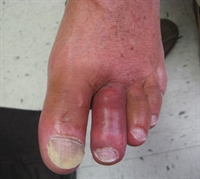 Is your nail starting to come off? Is it thick and yellow
colored? Is their pain in your toenail when you are wearing yours shoes? All of
these factors could point to you having fungus toenails. The fungus can cause
your toes to change color, thicken and quite frankly just be painful.
Is your nail starting to come off? Is it thick and yellow
colored? Is their pain in your toenail when you are wearing yours shoes? All of
these factors could point to you having fungus toenails. The fungus can cause
your toes to change color, thicken and quite frankly just be painful.
So, what can you do for these toenails? Well, if your
toenail is starting to lift off of its base, then you need to come in so that
we can clip it down to the point where it is still attached. As strange as it
may sound and look to have a short toenail, it would be much worse if that
toenail caught on your sock and ripped the whole thing off. Not to mention how
painful that would be.
Now, what about the color and the thickness? Well, fungus
nails can be very difficult to treat. So, we want to be as aggressive as
possible. There are topical creams and clear nail polish that can be painted on
to treat your nails. There is also an oral medication that you can take. It is
just important that you liver is monitored while you are on this medication to
make sure that you don’t have some side effects.
One of the best ways to treat your fungus toenails is using
a new technology. We use a laser that makes use of particular wavelengths to
kill the fungus. The most important thing that you need to remember is that the
laser is killing the fungus so that your new nail will look healthier. It will
not change the appearance of the old nail though. So, it will take 6 months to
a year for you to see a full change as your nail grows out. It may take longer
depending upon how slow your nail grows. Some people like to combine the
medication and the laser so that you are really treating the problem
aggressively.
If you or someone you know has thick, yellow, fungus nails,
it is important that you see your local podiatrist. If you live in the Pelham
or Windham, New Hampshire area, Dr. Wachtel would be more than happy to see you
and help treat your calluses. We are also happy to announce our Methuen and
North Andover offices located at 451 Andover St. Suite 300, North Andover and 87 Jackson St, Methuen.






